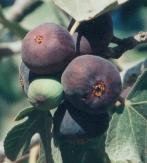
Figs
 Figs |
The Bible describes Israel as a land blessed with seven species (shiv'at haminim) of fruit and grain: "A land of wheat, barley, grape vines, figs and pomegranates, a land of olive oil and (date) honey'
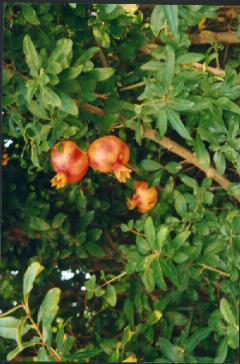 Pomegranates in Safed, northern Israel |
Grape growing is still a significant sector in Israeli agriculture. Historically wine making was an important local industry, as the many millennia old wine presses uncovered throughout the country testify. Modern Israel produces many quality local wines, with many small new wineries opening in recent years.
This revival of wine-making in part thanks to the nineteenth century Jewish philanthropist Baron Rothschild who brought his expertise in French wine making to Israel, re-establishing wine making as a serious industry in the Holy Land. He famously established the wineries in the towns of Zikhron Ya'akov and Rishon Letzion, where the well known Carmel wines are still produced. Other well known Israeli wine producers include Yarden (Golan wines), Barkan, Binyamina and Dalton.
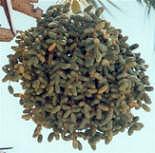 Ripening dates |
Dates are another of the seven species which are still an important crop, with many of the biggest growers located in the Jordan Valley, including kibbutzim such as Sde Eliahu and Tirat Tzvi. Israeli dates, both fresh and dried, are exported around the world. Date honey silan and similar date spreads and preserves are also produced.
In ancient times olive oil production was one of the region's major industries, supporting the populations of many entire villages and towns. Today Israel still produces good olive oil, mostly in the Galilee, though on a much smaller scale than in biblical and Roman times. A variety of quality and canned preserved, marinated and pickled olives are also produced here.
The remaining seven species are today grown mostly on a small scale for local consumption. Figs are enjoying something of a comeback with Israeli aficionados holding an annual conference on the subject.
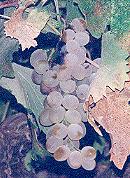 Late summer grapes |
The two grains are the first of the seven species to ripen after the winter rains. Ripening wild barley is a harbinger of Pesah(Passover), also known as Hag Ha-aviv,the spring festival. Before the Temple in Jerusalem was destroyed around 2000 years ago, Pesah was the festival of the omer,the barley offering. Roughly seven weeks later it's turn of the wheat, which was brought as an offering in the Temple during the festival of Shavu'ot (Pentecost) which falls during the katzir, wheat harvest.
Over the spring the other five species begin to ripen, the pomegranate trees magnificent with their red trumpet like flowers, the grapevines, date palms, olive and fig trees producing the first tiny, pea-sized fruits.
The grape harvest or batzir takes place around mid-summer. In ancient Israel this was the backdrop to the festival of Tu B'Av when the single women would go out into the vineyards in borrowed white dresses and dance in the hope of attracting a husband (see Mishnah Ta'anit 4:8). Some researchers, such as Noga Hereuveni from the Neot Kedumim biblical nature reserve
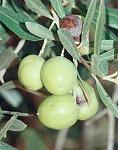 Ripening olives |
In modern Israel the grapes are generally harvested by machine and if you happen to be out late at night you may see the ghostly lights of the grape harvesters working into the wee hours of the morning to ensure that the grapes are picked at just the right time.
I love the late summer and autumn around the time of Rosh Hashanah (the Jewish New Year), when the fig, pomegranate and date trees are heavy with ripening fruit creating an atmosphere of renewal after the hot barren summer. It is a simple but wonderful pleasure to go on a hike in the middle of nowhere this time of year and to taste the first of the season's figs fresh from a wild fig tree.
The olive harvest or yitzhar lasts from the autumn to the start of winter, roughly from Sukkot(Tabernacles), also known as Hag Ha-Asif, the gathering festival, to the festival of Hannukah, one of whose central themes is the miracle of the little jar of olive oil, only enough to light the Temple lamp for one day, which lasted for eight days, long enough for fresh oil to be pressed from the new season's olives. In modern Israel there is an olive harvest festival in the Galilee around Sukkot, with special activities including of course the pressing of olives and other stages in the manufacture of olive oil.
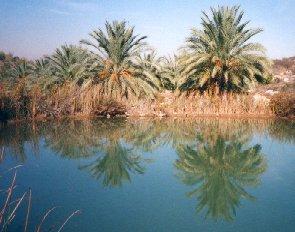 Date Palms at Neot Kedumim |
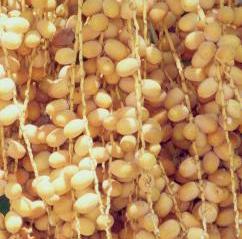 Yellow dates in the Jordan Valley |
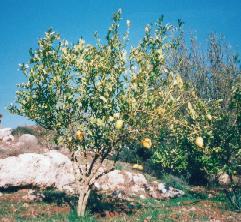 Citron (Etrog) |
The bible commands us to use four species in the celebration of the Sukkot festival: "and on the first day you shall take the fruit of the hadar tree, palm fronds and branches of myrtle and willow trees."(Leviticus 24:40).
Although today Israel is well known for its citrus produce and the Jaffa brand name has become a byword for tangy oranges, the only citrus known to have grown here in ancient times is the citron (etrog) described in the Bible as "the fruit of the glorious (hadar) tree" (Leviticus 24:40)In modern Hebrew hadar (glorified, beautiful) has come to refer to all citrus fruits.
The citron is not easy to grow. As my cousin in a nearby village tells me, it requires a lot of tender loving care. The other three species mentioned in the verse are far more common in Israel than the citron. I know of many people who have willows or myrtle growing in their gardens.
Come Sukkot these four species are sold in special makeshift markets across Israel and people spend days and hours selecting the finest for the festival. The village of Nov in the Golan Heights is famous for its myrtle branches, as are various other villages around the Sea of Galilee. Palm branches are often imported from El Arish in Sinai, Egypt, although they also grow locally.
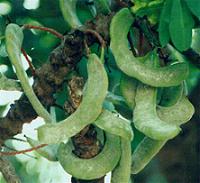 Fresh carobs in Adar (February/March) |
The citrons, the hardest to grow and the most beautiful of the four, is usually the most expensive. Customs vary from community to community, some buying small, lemon-sized fruit, others going for huge melon-sized etrogim, so large that they require to hands to hold.
Another special category of produce mentioned in the bible is zimrat ha-aretz which roughly translates as the gleanings of the land or the bountry of the land. These are mentioned as the gifts that Jacob sends down to the Egyptian governor (Joseph) to plea for food during a time of drought in the Land of Israel "take down to the man a present: a little balm, a little honey, spices, myrhh, botnim and almonds."(Genesis, 43:11)
In modern Hebrew botnim refers to peanuts, but in classical Hebrew the word referred to the fruit of the botnah tree, that is the pistachio tree, pistacia vera, or in modern Hebrew elat habotnah.
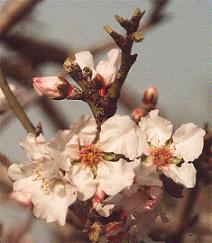 Almond blossoms in late January |
The identification of the honey isn't clear. Carob honey was quite widely used at the time, and would likely have been available even during a drought, as the fruit are commonly eaten dried, and so it's likely that in times of severe shortage there would at least have been dried carob left from the previous year. In addition the carob tree is hardy enough to survive harsh conditions when most other fruit baring trees stop yielding produce. Others say that the reference here is to date or bee's honey.
There are at least three wild species of almond tree in Israel. Come the midwinter festival of Tu B'Shvat, the Jewish new year for trees, their blossoms adorn rural hillsides and town gardens alike, dotting the landscape with pink-white puffs. Israel is believed to be one of the regions where the tree was domesticated and indeed almonds are still grown commercially here to this day.
Introduction to Israeli Flora |
Plants of the Bible |
More Plants of the Bible and Talmud |
Israeli botanical and nature links
Introduced species |
Trees and Flowers in the Modi'in area |
Copyright 2003 by Leiah Elbaum. Text and illustrations on this page are by Leiah Elbaum. Last updated 8 April 2003.